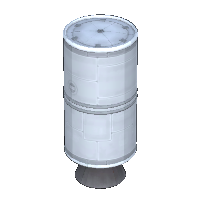RT-10 "Hammer" Solid Fuel Booster/ja
| RT-10 "ハマー" 固体燃料ブースター | ||
| Solid rocket booster によって Found lying by the side of the road | ||
| 接続サイズ | M, 側面設置 | |
| コスト | (合計) | 400.00 |
| (乾燥) | 175.00 | |
| 質量 | (合計) | 3.56 t |
| (乾燥) | 0.75 t | |
| 空気抵抗 | 0.2-0.3 | |
| 耐熱温度 | 2000 K | |
| Volume | ? | |
| 耐衝撃性 | 7 m/秒 | |
| 開発技術 | | |
| 開発導入費 | 1 200 | |
| バージョンから | 0.7.3 | |
| Part configuration | solidBoosterRT-10.cfg | |
| Solid rocket booster | ||
| 最大推力 | (1 atm) | 197.90 kN |
| (真空) | 227.00 kN | |
| 比推力 | (1 atm) | 170 秒 |
| (真空) | 195 秒 | |
| 燃料流量 | 15.83
| |
| 推力偏向 | いいえ | |
| 燃料 | 375.0 | |
| 燃焼時間 | (1 atm) | 20.7 秒 |
| (真空) | 23.7 秒 | |
| Testing Environments | ||
| On the surface | いいえ | |
| In the ocean | いいえ | |
| On the launchpad | はい | |
| In the atmosphere | はい | |
| Sub orbital | はい | |
| In an orbit | はい | |
| On an escape | いいえ | |
| Docked | いいえ | |
| Test by staging | はい | |
| Manually testable | はい | |
The RT-10 Solid Fuel Booster (also known as an SRB) is a solid rocket booster used to provide a short burst of additional thrust to a rocket. It comes as a single unit. The engine and fuel tank are one single part which means that it isn't possible increase the burn time for it by adding more fuel tanks.
Contents
Usage
The RT-10 is a solid rocket booster (SRB) that can be fired once, cannot be shut down or throttled while operating, and is notable for its very high specific thrust (500N/kg and does not require separate tanks) and high propellant fraction (0.867). This makes it very useful for the lift-off stage of a large launch vehicle early in Career games when the Rockomax Mainsail and Skipper engines are not yet available. Traditionally, only staggered and ripple-firing techniques were available to modulate thrust, however, starting with 0.23, the thrust and propellant load can be adjusted by right clicking on the part in the vehicle editor (VAB or SPH). This makes it easier to use for smaller boosters.
Another possible use is as a kick stage for imparting high impulses to a very light payload: in this role, the high propellant fraction of the RT-10s offsets the low vacuum specific impulse and results in a high mass ratio. The high thrust allows a complete burn while in the vicinity of a planet, taking advantage of the Oberth effect. The short maneuver duration makes the predicted outcome of an associated maneuver node more accurate. Starting with editor tweaking in 0.23, it is now possible to off-load propellants, but since this can't be done in flight, careful planning is still required (The LV-909 Liquid Fuel Engine is recommended for beginners, reached by researching Survivability immediately after Basic Rocketry.)
RT-10 Solid Fuel Boosters are prone to overheating, especially when large numbers are clustered together. The main ways to overcome this are ripple firing to keep too many in the cluster from firing at once, attaching "cooling" parts (typically struts, control surfaces or winglets), and by reducing the thrust by right-clicking the part in the editor (since 0.23). There is also a glitch in which attaching an RCS thruster completely prevents overheating.
Deliberately overheating the RT-10, such as by stacking two and firing the upper before the lower has burned out, allows the motor to function as an ad hoc decoupler (see explosive decoupling.) This is useful in mission-race Career games for maximizing Science while at the lowest level of the technology tree, before proper decouplers are available. It will also make the crew panic, including Jebediah.
Thrust can be regulated with tweakables, minimum required for booster to lift it's own weight off Kerbin surface is 15%. Thrust limiter allows for longer burns with lower acceleration. Specific impulse is identical for all thrust limiter settings.
Product description
| 「 | While considered by some to be little more than "a trash bin full o' boom", The RT-10 is used in many space programs, whenever the need to save cash is greater than the need to keep astronauts alive. Use with caution, though. Once lit, solid fuel motors cannot be put out until the fuel runs out. | 」 |
Trivia
Between 0.7.3 and 0.15.2, the RT-10 was of limited use, mainly for providing extra challenge or silliness related to its high thrust to weight ratio. In rare cases it provided a small performance boost from overcoming the sticky pad bug or getting a rocket up to ideal speed.
In 0.16, the RT-10 had a specific impulse (or Isp) of 442.4 s, higher than any other solid or liquid fuel rocket, making a useful, if situational, choice (especially during launch). However, its increased mass in 0.17 reduced its Isp to 212.4 s. Other than these foibles, the RT-10 is possibly the most consistent original part, still looking and behaving much as it did in the earliest releases.
Changes
- New model and texture
- Full mass increased from 1.8 to 3.5 tons; dry mass increased from 0.36 to 0.5 tons.
- Thrust increased from 130 to 250 (part rebalancing)
- New texture for the Solid Rocket Booster
- Initial Release
| ||||||||||||||||||||

